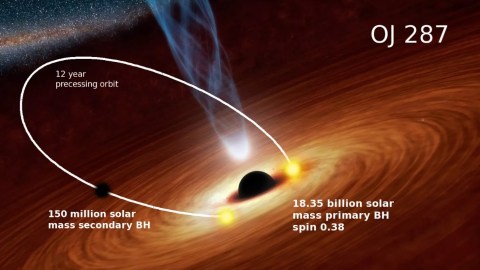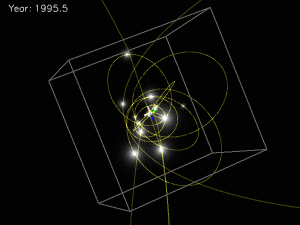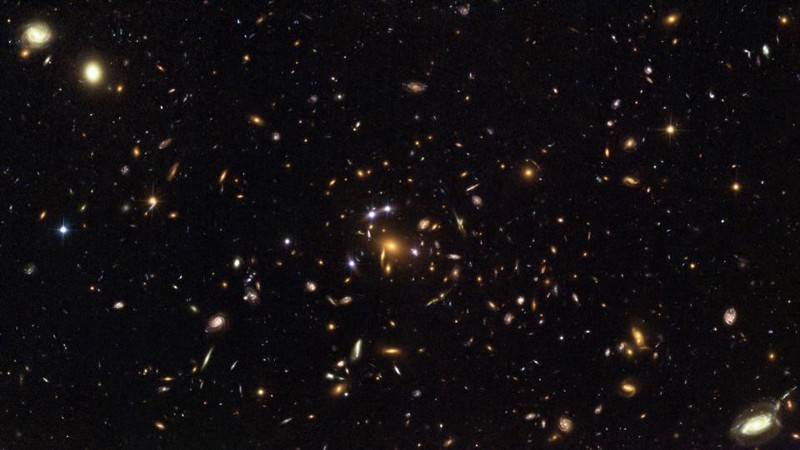Solved: Astronomers identify origin of mysterious flares in galaxy OJ 287

- A longstanding mystery surrounding periodic flares in the distant galaxy OJ 287 has been solved, with astronomers identifying the source as two supermassive black holes that orbit each other.
- As they orbit each other, the smaller black hole passes through the larger one’s accretion disk, creating immense flares detectable from Earth.
- The research not only provides detailed insights into this intergalactic spectacle but also predicts the eventual merging of these two black holes in approximately 10,000 years, ending their cosmic dance.
Periodic flares observed in a distant galaxy have mystified astronomers for years. A recently published study has solved the mystery: Two enormous black holes are locked together in a cosmic dance.
Supermassive black holes (SMBH) are the biggest known compact objects in the Universe. With a radius about the size of the solar system, these cosmic leviathans have masses that are millions or billions of times that of our Sun. They can be found at the center of nearly every galaxy.
If one such black hole is interesting, two are even more fascinating. When two galaxies collide and coalesce into a single larger galaxy, each galaxy’s SMBH participates in the process. Over time, the two SMBHs begin to orbit one another, forming what is called a supermassive black hole binary system.
Because black holes emit no light, they are invisible. But it’s possible to detect their presence through how they interact with their surroundings, meaning scientists can “see” them indirectly.
A cosmic dance
The galaxy OJ 287 is located about 5 billion light-years away from Earth. It was first observed in 1888 in photographic images and in the 1960s was found to emit radio waves by the Big Ear Radio Observatory, operated by Ohio State University. The galaxy emits periodic flashes of light, with two different periodicities: one repeating every 12 years and the other repeating every 55.
Astronomers have long suspected that the observed flashes result from two SMBHs orbiting one another. In a recent paper, researchers described improved predictions of the behavior of these cosmic colossuses.
At the center of OJ 287, there exist two SMBHs. The larger has a mass that is 18.5 billion times heavier than the Sun and a radius about nine times larger than the orbit of Pluto. The smaller black hole has a mass of 150 million solar masses, with a radius larger than the orbit of Mars. The smaller hole orbits the larger one for a period of about 12 years.
Meanwhile, the orbit of the smaller black hole fluctuates. It precesses around the larger hole, kind of like a spirograph. With each orbit, the location of the perigee (the location where the two holes are closest together) “walks” around the larger hole. After about ten orbits, the pattern repeats itself.
The larger black hole is surrounded by an accretion disk — a disk of matter that orbits the hole. The disk somewhat resembles the rings of Saturn, except that it orbits more quickly, and it is heated by interactions between material in the disk.
The smaller black hole doesn’t orbit in the same plane as the accretion disk. Instead, the hole’s orbit is tilted by a very large angle. Thus, as the smaller hole orbits the larger one, it plunges through the accretion disk twice, once going down and then returning upward.
The source of the flares
The flares are created as the smaller black hole passes through the accretion disk. As the smaller black hole passes through the accretion disk, the disk is heated, its temperature returning to normal after about a month.
However, while the smaller black hole passes through the disk, it also “eats” some of the material. As the material flows toward the black hole, large magnetic fields are set up that guide some of the material away from the smaller black hole in the form of a jet. This jet moves at very high velocities and interacts with the gas in the accretion disk. This interaction emits gamma rays, creating the very intense flares that we observe. Over the course of about a day, the black hole emits light equivalent to a trillion Suns.
In the recently published article, researchers modeled the dynamics of the two orbiting holes, including how the incoming hole distorts the shape of the accretion ring through gravitational interactions.
The team studied the light emissions across a broad range, from radio waves to gamma rays. They pinpointed the moment when the observed flares occurred, as well as the sequence in which different wavelengths of electromagnetic radiation were released.
The study modeled observations going back over a hundred years and predicted flares that were observed in the period from January to February of 2022.
Orbiting black holes emit energy via gravitational radiation and, in the case of OJ 287, through the interaction of the smaller black hole and the accretion disk. Researchers predict that in about 10,000 years, the two holes will merge in an event that will shake the fabric of space and time and end their cosmic dance.




